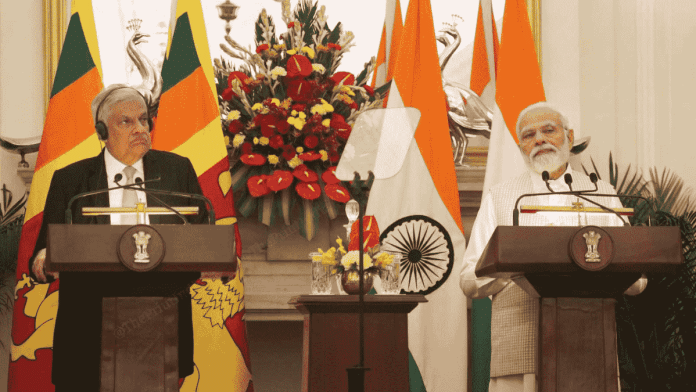New Delhi: Better air and maritime connectivity, enhanced trade relations, strengthening infrastructure, and better people-to-people connectivity. These are some of the cornerstones of a new India-Sri Lanka vision document that the two countries released jointly Friday during Sri Lankan President Ranil Wickremesinghe’s first official visit to New Delhi since he took office last year.
Called the ‘Promoting Connectivity, Catalysing Prosperity: India-Sri Lanka Economic Partnership Vision’, the document, which Wickremesinghe released jointly with Prime Minister Narendra Modi at Hyderabad House Friday, aims to strengthen bilateral ties and comes as the two countries celebrate the 75th year of their diplomatic ties.
At the media briefing, Modi said Sri Lanka plays an essential role in India’s ‘Neighbourhood First’ and ‘Security and Growth for All in the Region (SAGAR)’ policies. While the former prioritises India’s neighbourhood in its foreign policy, the latter is a maritime initiative that focuses on the Indian Ocean Region to ensure India’s peace, stability, and prosperity.
Modi said that throughout the challenges Sri Lanka had faced over the last year, India stood “like a close friend, stood shoulder to shoulder with the people of the island nation”.
In April 2022, Sri Lanka declared its first sovereign debt default — triggered by a forex shortage — amid the worst economic crisis to hit since its independence in 1948. The island nation witnessed soaring inflation, a massive power crisis, and shortages of medicine, fuel and other essentials.
The ensuing street protests led to the ouster of then president Gotabaya Rajapaksa, with Ranil Wiskremesinghe eventually replacing him. The Sri Lankan president’s visit comes at a time when his country is making its slow way back to recovery — a topic that was also discussed at Friday’s meeting.
Also Read: IMF bailout only became possible due to Indian support, says Sri Lankan envoy Moragoda
Growing ties across trade, energy projects
According to the vision document, the two countries have decided to strengthen relationship in five areas: air connectivity, maritime connectivity, energy and power connectivity, trade, economic and financial connectivity, and people-to-people connectivity.
Under the agreement, the two countries have agreed to work on various projects, such as strengthening infrastructure at Colombo, Trincomalee and Kankesanthurai, building a high-capacity power grid interconnection between the two countries, and construction of a multi-product petroleum pipeline, among others. The two countries also aim to “enhance growth in the Indian Ocean Region”.
“The leaders underscored the unparalleled advantages afforded by civilisational ties, geographical proximity, cultural connect and age-old goodwill between the peoples of the two countries and reaffirmed their endeavour to harness existing synergies and complementarities in a manner that brings shared and sustainable economic prosperity,” the vision document says.
The document also says that New Delhi and Colombo will continue discussions on several other initiatives such as the Economic and Technology Cooperation Agreement — which seeks to boost cooperation in technical areas, scientific expertise and research among institutions in the two countries — and also undertake joint exploration of Sri Lanka’s offshore oil basins and support India’s investments in Sri Lankan state companies.
During the visit, Wickremesinghe signed numerous Memorandums of Understanding (MoUs) with New Delhi on renewable energy as well as introducing Unified Payments Interface (UPI) in Sri Lanka.
They also agreed on developing the northeastern city of Trincomalee and starting passenger ferry services between Nagapattinam in Tamil Nadu and Kankesanturai in Sri Lanka in an effort to improve connectivity between the two countries.
Sri Lanka’s economic recovery
The two leaders also discussed the state of the Sri Lankan economy at the meeting.
“I have also appraised Prime Minister Modi of the extraordinary challenges that Sri Lanka has experienced in economic, social and political terms in the past year and of the reform measures I have spearheaded on a number of fronts in overcoming these challenges,” Wickremesinghe said at the joint press conference.
India had provided Sri Lanka critical support during its crisis last year, extending about $4 billion in rapid assistance between January and July, including credit lines, a currency-swap arrangement and deferred import payments. New Delhi also sent essential imports, including drugs delivered by a warship.
Also discussed at the meeting was the 13th amendment — a provision that mandates the setting up of provincial councils to devolve power from Colombo — and its delayed implementation.
The 13th Amendment was brought about following the 1987 Indo-Sri Lankan Peace Accord and was aimed at decentralising the country’s governance system and giving its Tamil population — especially in the north and east regions — more political autonomy.
India has been pushing Sri Lanka to implement the amendment, which also makes Tamil a national language.
At the press conference, Modi said the Sri Lankan president has promised to ensure that the rights of the Tamils are respected and said that the island nation will hold provincial council elections soon.
(Edited by Uttara Ramaswamy)
Also Read: Why India should pull Sri Lanka out of China’s ‘debt trap’ and take it closer to the US






